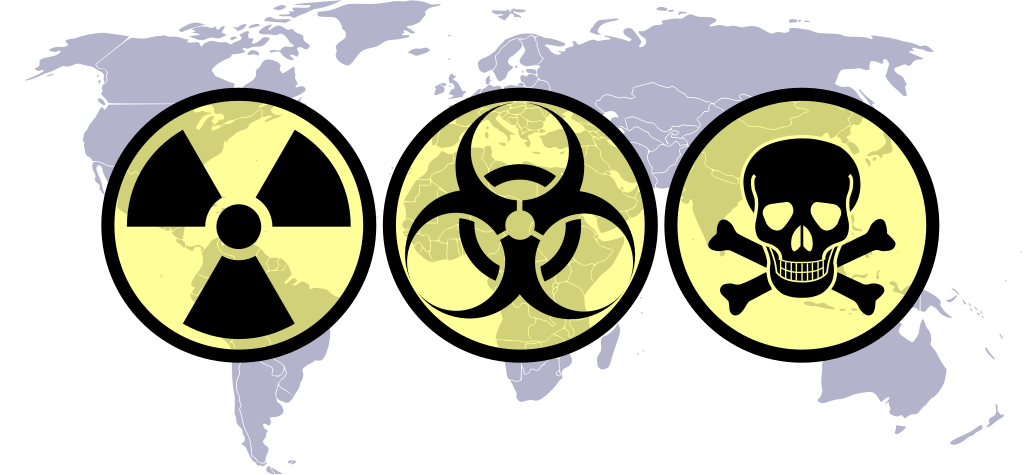weapon of mass destruction / WMD / conventional weapon

Most people became aware of the terms weapon of mass destruction and WMD during the run up to the first Gulf War in 1990–91. And they again entered the public consciousness during the second war with Iraq which started twelve years later. Both times Saddam Hussein had been thought to have developed nuclear, biological, and chemical weapons, an assessment that was only correct the first time. But the term is much older than widespread public awareness of it.
The term weapon of mass destruction dates to at least 27 December 1937, when it was used by William Cosmo Gordon Lang, the archbishop of Canterbury in a speech. He uttered the phrase in the context of the bombing of cities in Spain and China by fascist air forces. Lang was using the term not in the sense of nuclear, biological, or chemical weapons, but rather conventional weapons that were used indiscriminately against civilians:
Who can think without horror of what another widespread war would mean, waged as it would be with all the new weapons of mass destruction? Yet how fruitless seem to be all efforts to secure a really settled peace.
The abbreviation WMD dates to at least 1985, when it appears in a master’s thesis on the Outer Space Treaty of 1966. Again, the definition here is an expansive one:
Taking into account the circumstances under which the Space Treaty was concluded, it would be difficult to view Article IV a derogation of the common interest principle. Aside from Article IV(2) which totally demilitarize [sic] the moon and other celestial bodies, the ban under Article IV (1) on the “weapon of mass destruction” (WMD) is noteworthy. The concept of WMD is not a static one. It not only embraces weapons of this kind which had existed before the conclusion of the Space Treaty, such as chemical and biological weapons; but also encompasses weapons of mass destruction to be developed in future. In judging whether a particular weapon is WMD, it is the effect and destructiveness caused by this weapon that should count, not the question of whether a weapon is conventional or non-conventional. Moreover, the means by which mass destruction can be caused is only secondary. The direct killing is equal to killing by destroying crops, by flooding large living areas, or by any other kind of modification of our natural environment.
Article IV of that 1966 treaty reads:
States Parties to the Treaty undertake not to place in orbit around the Earth any objects carrying nuclear weapons or any other kinds of weapons of mass destruction, install such weapons on celestial bodies, or station weapons in outer space in any other manner.
The Moon and other celestial bodies shall be used by all States Parties to the Treaty exclusively for peaceful purposes. The establishment of military bases, installations and fortifications, the testing of any type of weapons and the conduct of military manœuvres on celestial bodies shall be forbidden. The use of military personnel for scientific research or for any other peaceful purposes shall not be prohibited. The use of any equipment or facility necessary for peaceful exploration of the Moon and other celestial bodies shall also not be prohibited.
The counterparts to WMD are conventional weapons. That term, used in contrast to nuclear weapons, appears, as one might expect, shortly after the bombing of Hiroshima and Nagasaki. There is this from Illinois’s Centralia Evening Sentinel of 16 October 1945:
The general’s [i.e., Lt. Gen. Curtis LeMay’s] plain speaking is welcome at a time when the whole country has been understandably confused about the whole subject of atomic power. There has been a tendency to assume that there was no possible defense against the bomb, and that aircraft and other conventional weapons have been ruled out.
And there is this from Ohio’s Cincinnati Post of 4 July 1946, shortly after the first atomic tests on Bikini Atoll in the Pacific:
There is no tendency on the part of anybody here to question that the plutonium bomb is a vastly more dangerous weapon in the hands of any enemy than any conventional weapon ever conceived.
A note on usage. When I was working arms control issues in the Pentagon in the early 1990s, we actively tried to discourage use of the terms weapons of mass destruction and WMD. Our thinking was that nuclear weapons were orders of magnitude more destructive than even biological or chemical weapons, and that putting them in the same category was committing an analytical error and would lead to poor policy outcomes. We were not successful in quashing use of the terms.
Sources:
Heath, S. Burton. “Bikini Atomic Bomb Blast Pleases Navy.” Cincinnati Post (Ohio), 4 July 1946, 16/4–5. Readex: America’s Historical Newspapers.
Huang, Jiefang. The Common Interest Principle in Space Law (LL.M thesis). Institute of Air and Space Law, McGill University, June 1985, 196–97. ProQuest Dissertations.
“In the Arm Chair.” Centralia Evening Sentinel (Illinois), 16 October 1945, 8/1. NewspaperArchive.com.
Oxford English Dictionary, third edition, 2005, s.v. weapon of mass destruction, n., WMD, n.
“Primate Appeals to the Individual in His Home.” Scotsman (Edinburgh), 27 December 1937, 15/3. ProQuest Historical Newspapers.
Treaty on Principles Governing the Activities of States in the Exploration and Use of Outer Space, including the Moon and Other Celestial Bodies (1966). United Nations Office for Outer Space Affairs.
Image credit: Fastfission, 2006. Wikimedia Commons. Licensed under a Creative Commons Attribution-Share Alike 3.0 Unported license.